Four O'Clock Factoid is a daily feature on Track Twenty-Nine helping to get you through the workday with a bit of useless knowledge.
Geisterbahnhöfe (German: Ghost Stations) originally referred to closed subway stations in Berlin, through which trains passed without stopping due to the division of the city by the Berlin Wall. Some U-bahn or S-bahn lines ran for the most part in West Berlin, but passed through the Soviet Sector in the center of the city. Patrons could ride along these lines through East Berlin, but trains did not stop. The Geisterbahnhöfe were dimly lit and patrolled by East German border guards. Trains did stop at Friedrichstraße, which was a transfer point between Western lines and also a border crossing into East Berlin. The Western lines with Ghost Stations were today's U6 and U8 and the Nord-Süd Bahn of the S-bahn.
Here is a 1984 map of the U- and S-bahn networks produced by the Western operator, BVG. Geisterbahnhöfe are labeled as Bahnhöfe auf denen die Züge nicht halten (stations at which trains do not stop). On Eastern U- and S-bahn maps, West Berlin is depicted as having no infrastructure, and the Western lines passing through East Berlin are not shown. Here is an Eastern 1984 map.
Friday, January 29, 2010
Photo Friday: Morning Skies
Photo Friday is a series showcasing a photo of mine each week. Enjoy!

A view of Midtown Atlanta from one of my favorite spots:the eastern shore of Lake Clara Meer in Piedmont Park
My photostream

A view of Midtown Atlanta from one of my favorite spots:
My photostream
Thursday, January 28, 2010
Four O'Clock Factoid: The Nearest Doorway to Heaven
Four O'Clock Factoid is a daily feature on Track Twenty-Nine helping to get you through the workday with a bit of useless knowledge.
The Qingzang Railway holds the title of world's highest railroad. It passes through the Tanggula Pass near Wenquan, Tibet, at an elevation of 17,162 feet (5,231 meters) above sea level. The line, which opened in 2006, has the nickname 'the nearest door to the heaven.'
The Qingzang Railway holds the title of world's highest railroad. It passes through the Tanggula Pass near Wenquan, Tibet, at an elevation of 17,162 feet (5,231 meters) above sea level. The line, which opened in 2006, has the nickname 'the nearest door to the heaven.'
Wednesday, January 27, 2010
Four O'Clock Factoid: The Really Fast Mail
Four O'Clock Factoid is a daily feature on Track Twenty-Nine helping to get you through the workday with a bit of useless knowledge.
The Wreck of the Old 97 was a train crash that occurred September 23, 1903. Southern Railway's Fast Mail was a train bound for Spencer, North Carolina. It was already late when it left Washington, and at Monroe, Virginia the engineer was instructed not to be late arriving in Spencer. The typical average speed taken between Monroe and Spencer was 39 mph, but in order to be on time, the train would have to average at least 51 miles per hour. At Danville, Virginia, the train left the tracks on the trestle over Cherrystone Creek, traveling at over 50 mph. Nine people were killed in the wreck, which inspired a well-known ballad of the same name.
The Wreck of the Old 97 was a train crash that occurred September 23, 1903. Southern Railway's Fast Mail was a train bound for Spencer, North Carolina. It was already late when it left Washington, and at Monroe, Virginia the engineer was instructed not to be late arriving in Spencer. The typical average speed taken between Monroe and Spencer was 39 mph, but in order to be on time, the train would have to average at least 51 miles per hour. At Danville, Virginia, the train left the tracks on the trestle over Cherrystone Creek, traveling at over 50 mph. Nine people were killed in the wreck, which inspired a well-known ballad of the same name.
Tuesday, January 26, 2010
Four O'Clock Factoid: Precursor
Four O'Clock Factoid is a daily feature on Track Twenty-Nine helping to get you through the workday with a bit of useless knowledge.
Levittown, New York was the first mass-produced, planned suburb of the post-war era. It is largely considered to have set the archetype for most suburban development in the United States from the 1940s on. The first Levittown was on Long Island, but others were built in New Jersey, Pennsylvania, and Puerto Rico.
Levittown, New York was the first mass-produced, planned suburb of the post-war era. It is largely considered to have set the archetype for most suburban development in the United States from the 1940s on. The first Levittown was on Long Island, but others were built in New Jersey, Pennsylvania, and Puerto Rico.
Transit Tuesday: The Name Game
 *Please see below for a correction
*Please see below for a correctionTransit Tuesday is a weekly feature or profile on transit.
In recent years, many transit agencies in the United States and abroad have converted to contactless RFID cards. And many have used this opportunity to rebrand their fare system, perhaps even the transit system as a whole.
In recent years, many transit agencies in the United States and abroad have converted to contactless RFID cards. And many have used this opportunity to rebrand their fare system, perhaps even the transit system as a whole.
Let's take a look at what rail operators have named their RFID cards:
- Atlanta - MARTA - "Breeze Card"
- Boston - T - "CharlieCard"
- Chicago - L - "Chicago Card"
- Miami - Metro - "EASY Card"
- New York - PATH - "SmartLink"
- Philadelphia - PATCO - "Freedom Card"
- San Diego - Coaster, Trolley, Sprinter - "Compass Card"
- San Francisco - BART, Caltrain, Muni - "TransLink"
- Seattle - Link, Sounder - "ORCA Card"
- Washington - Metro - "SmarTrip"
Most of these smart cards are used region-wide. For instance, in the Atlanta area, the Breeze Card can be used on MARTA rail and bus, C-Tran , Cobb Community Transit, Gwinnett County Transit, and XpressGA buses. Washington's SmarTrip can be used on all transit systems in the region, except for MARC and VRE, the commuter rail operators.
Names often reflect the history of the region or the system. Boston's CharlieCard, for instance, is a reference to the protest song "Charlie on the MTA", which was written in 1948 to oppose fare increases. The Charm Card references to Baltimore's nickname, Charm City. Seattle's ORCA is actually an acronym, short for One Regional Card for All.
Some are still in the roll out phases and will eventually be accepted in more places. Other places are planning to have the technology soon, including Baltimore's "Charm Card," expected later this year.
*Correction:Last week's Transit Tuesday included an error, for which I apologize.In my analysis of fares, I used the longest-distance trip on BART to calculate the highest fare, because BART does not list the highest fare on their website. The trip I used for the calculation was between Millbrae and Pittsburg/Bay Point. That trip, which passes through San Francisco Airport station costs $7.05. However, a trip from San Francisco Airport to Pittburg/Bay Point costs $10.90. This is due to a surcharge added to trips to/from SFO Airport Station. Again, I apologize for the bad data. Thanks to DavidJ for the tip.
Again, I apologize for the bad data. I do my best to provide accurate and informative data, and will continue to do so. If you see something you think is an error, please notify me.
Monday, January 25, 2010
Four O'Clock Factoid: Spanish Solution
Four O'Clock Factoid is a daily feature on Track Twenty-Nine helping to get you through the workday with a bit of useless knowledge.
 The term Spanish Solution refers to a transit station design principle whereupon platforms are located on both sides of a track. This is used at high-volume stations to make it easier for patrons to board and alight. Sometimes one platform is reserved for boarding and the other for alighting, in other instances either platform can be used for either purpose. Examples include Atlanta's Five Points station, Munich's Marienplatz (S-bahn), and Charles de Gaulle - Etoile on Line 6 in Paris. It takes its name from early implementation on Barcelona's Metro, although the earliest instance occurred at Park Street Under (Red Line) in Boston in 1912.
The term Spanish Solution refers to a transit station design principle whereupon platforms are located on both sides of a track. This is used at high-volume stations to make it easier for patrons to board and alight. Sometimes one platform is reserved for boarding and the other for alighting, in other instances either platform can be used for either purpose. Examples include Atlanta's Five Points station, Munich's Marienplatz (S-bahn), and Charles de Gaulle - Etoile on Line 6 in Paris. It takes its name from early implementation on Barcelona's Metro, although the earliest instance occurred at Park Street Under (Red Line) in Boston in 1912.
 The term Spanish Solution refers to a transit station design principle whereupon platforms are located on both sides of a track. This is used at high-volume stations to make it easier for patrons to board and alight. Sometimes one platform is reserved for boarding and the other for alighting, in other instances either platform can be used for either purpose. Examples include Atlanta's Five Points station, Munich's Marienplatz (S-bahn), and Charles de Gaulle - Etoile on Line 6 in Paris. It takes its name from early implementation on Barcelona's Metro, although the earliest instance occurred at Park Street Under (Red Line) in Boston in 1912.
The term Spanish Solution refers to a transit station design principle whereupon platforms are located on both sides of a track. This is used at high-volume stations to make it easier for patrons to board and alight. Sometimes one platform is reserved for boarding and the other for alighting, in other instances either platform can be used for either purpose. Examples include Atlanta's Five Points station, Munich's Marienplatz (S-bahn), and Charles de Gaulle - Etoile on Line 6 in Paris. It takes its name from early implementation on Barcelona's Metro, although the earliest instance occurred at Park Street Under (Red Line) in Boston in 1912.
Monday Shot: Sonderzug
Monday Shot isn't quite espresso, but hopefully this weekly transit picture will help get your week started.
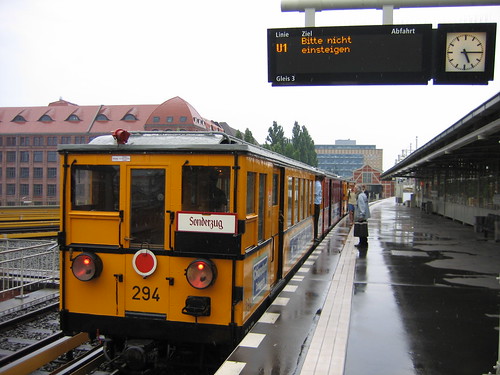
I happened across this Sonderzug (special train) at WarschauerStraße U-Bahn Station when I visited Berlin in 2005
My photostream

I happened across this Sonderzug (special train) at Warschauer
My photostream
Friday, January 22, 2010
Four O'Clock Factoid: Bulwark becomes Boulevard
Four O'Clock Factoid is a daily feature on Track Twenty-Nine helping to get you through the workday with a bit of useless knowledge.
Baron Georges-Eugène Haussmann is largely credited with creating the modern Paris. His plan of avenues created large open spaces by cutting through the medieval city. Planning and construction of the Haussmann proposal occurred in the mid-1800s under Napoleon III. It was Haussmann's plan that brought the word "Boulevard" into common usage and which also contributed strongly to the City Beautiful Movement.
Baron Georges-Eugène Haussmann is largely credited with creating the modern Paris. His plan of avenues created large open spaces by cutting through the medieval city. Planning and construction of the Haussmann proposal occurred in the mid-1800s under Napoleon III. It was Haussmann's plan that brought the word "Boulevard" into common usage and which also contributed strongly to the City Beautiful Movement.
Photo Friday: Winter Sunset
Photo Friday is a series showcasing a photo of mine each week. Enjoy!
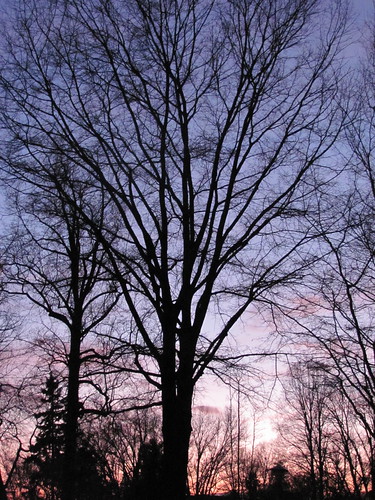
I loved the color contrast of the sunset with the darkness ofthe bare trees in this shot from Silver Spring's Woodside Park
My photostream

I loved the color contrast of the sunset with the darkness of
My photostream
Thursday, January 21, 2010
Four O'Clock: Nationalizing
Four O'Clock Factoid is a daily feature on Track Twenty-Nine helping to get you through the workday with a bit of useless knowledge.
Railpax was the intended brand name for the National Railroad Passenger Corporation. At the last minute, the name was changed to Amtrak. The NRPC was formed in 1970 and service began in May 1971.
Railpax was the intended brand name for the National Railroad Passenger Corporation. At the last minute, the name was changed to Amtrak. The NRPC was formed in 1970 and service began in May 1971.
Wednesday, January 20, 2010
Four O'Clock Factoid: Dense Stop Spacing
Four O'Clock Factoid is a daily feature on Track Twenty-Nine helping to get you through the workday with a bit of useless knowledge.
Paris has one of the highest densities of transit stations anywhere. In the 41 square mile city, there are 245 Metro stations - roughly one for every 0.17 (one-fifth) of a mile. And that figure doesn't count the RER stations also in the city limits.
Paris has one of the highest densities of transit stations anywhere. In the 41 square mile city, there are 245 Metro stations - roughly one for every 0.17 (one-fifth) of a mile. And that figure doesn't count the RER stations also in the city limits.
Tuesday, January 19, 2010
Four O'Clock Factoid: Christmas Present
Four O'Clock Factoid is a daily feature on Track Twenty-Nine helping to get you through the workday with a bit of useless knowledge.
Savannah, Georgia was the original capital of the colony and, later, the state of Georgia. It is an early example of town planning in the United States, with a rectilinear street grid intersecting a set of squares. The squares had space reserved for public and religious buildings on their edges. In December 1864, after capturing the city in his March to the Sea, General William Sherman gave Savannah to President Lincoln as a 'Christmas present.'
Savannah, Georgia was the original capital of the colony and, later, the state of Georgia. It is an early example of town planning in the United States, with a rectilinear street grid intersecting a set of squares. The squares had space reserved for public and religious buildings on their edges. In December 1864, after capturing the city in his March to the Sea, General William Sherman gave Savannah to President Lincoln as a 'Christmas present.'
George Takei: Transit Geek
George Takei is well known for his iconic role as Captian Sulu on the Star Trek television series and films. What is less well known is his role as a member of the board of directors of the Southern California Rapid Transit District for 11 years. In fact, in 1978, he was called away from the set of Star Trek: The Motion Picture to cast the tie-breaking vote to approve the pursuit of a subway system for Los Angeles.
He was recently interviewed on NPR's Wait Wait... Don't Tell Me!, a weekly news quiz show, in the segment known as "Not My Job."
I'm a huge fan of Wait Wait, and this is my favorite episode. Ever.
Takei talks about Star Trek, gay marriage, and, surprisingly, transit. You really should listen to the whole segment (here, 11:36), but I've transcribed a small excerpt below:
I particularly love Peter Sagal's response. I'm an unabashed transit geek, and I certainly know the reaction - when peoples' eyes start to glaze over - but it's totally worth it to meet another transit geek.
Anyway, this episode of Wait Wait totally made my day. I just had to share.
He was recently interviewed on NPR's Wait Wait... Don't Tell Me!, a weekly news quiz show, in the segment known as "Not My Job."
I'm a huge fan of Wait Wait, and this is my favorite episode. Ever.
Takei talks about Star Trek, gay marriage, and, surprisingly, transit. You really should listen to the whole segment (here, 11:36), but I've transcribed a small excerpt below:
Mo Rocca: Can I just add...? I feel a little left out, because I'm actually not a Star Trek geek.
George Takei: You're not?
MR: I'm not, but I am a rapid transit geek.
GT: You sound like one.
MR: I'm not a Star Trek geek, I just get mistaken for one constantly. But I am a rapid transit geek, and I just wanted to know, is there any future in the monorail?
GT: Here in Los Angeles?
MR: Just anywhere. I love them.
GT: You do? (laughter) Um, no. What we're doing here in Los Angeles is building a network of light rail because that's less costly. And putting the focus on extending the stub-ended Wilshire Line. And we want to extend that to--
Peter Sagal: Is this what other people feel like when we're talking about Star Trek? (laughter)
Adam Felber: Yeah.
MR: I love it.
PS: I'm like 'blah-de-blah-de-blah.'
GT: Sorry about that.
PS: It's all right.
MR: You just don't get it. We have conventions. This is awesome!
PS: You all dress up as conductors...
AF: If the Purple Line is going to be powered by dilithium, then...(laughter)
GT: Dilithium crystals, yes.
I particularly love Peter Sagal's response. I'm an unabashed transit geek, and I certainly know the reaction - when peoples' eyes start to glaze over - but it's totally worth it to meet another transit geek.
Anyway, this episode of Wait Wait totally made my day. I just had to share.
Transit Tuesday: Fare Enough
*Please see below for a correction.
The recent economic hardship in the United States has created major budget problems for most, if not all, transit agencies in the country. As a result, many have raised fares in the past few months or are considering such a move. This week, Transit Tuesday takes a look at heavy and light rail transit fares around the nation.
Systems have been divided into three categories: Those operating heavy rail, those operating light rail, and those operating both. Because commuter rail operators typically have different fare policies, they were not considered in this analysis.
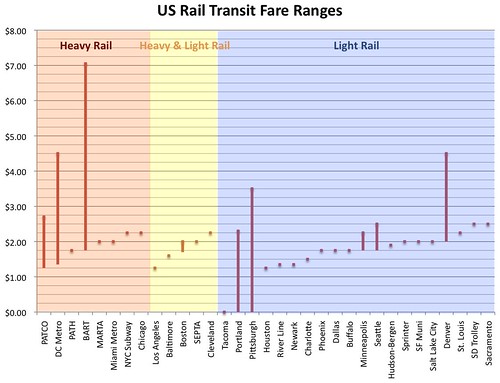
Note: This chart contains an error. The highest fare on BART is actually $10.90.
Among heavy rail (only) operators, the lowest fare is found on Philadelphia's PATCO Speedline, which has a graduated fare system based on distance traveled. The shortest trips cost $1.25, however, longer trips can cost as much as $2.70. The highest flat fares are found in New York and Chicago, where access to the Subway and the L costs $2.25. The honor of highest fare goes to BART in the San Francisco Bay Area. The longest trip results in a fare of $7.05 $10.90, however shorter trips can cost as little as $1.75.
Among operators of mixed systems, the lowest fare can be found in Los Angeles, where Metro charges a $1.25 flat fare. The highest flat fare is found in Cleveland, where it costs $2.25. Boston charges a flat fare, but charges different rates for customers using their RFID Charlie Card: $1.75 with the card, $2.00 cash or magstripe card.
Light rail (only) operators also see quite a range. Sound Transit's Tacoma (Washington) Link is a free service, so it holds the title of cheapest light rail. Portland and Pittsburgh both have fare-free areas downtown, but do charge for trips outside of that area - in Pittsburgh, as much as $3.50 during rush hours. Denver's RTD has the highest possible fare at $4.50, but it ranges as low as $2.00 for shorter trips. The highest flat fares are found in San Diego and Sacramento, where each ride costs $2.50.
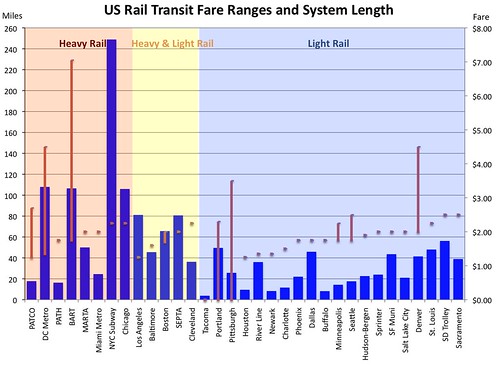
The amount of access to the transportation system per cost is probably the best measure of value. This (brief) analysis does not consider how far one can travel per actual unit of fare, but the above chart does show the total rail system length in miles. Compare Washington's Metro with BART. The DC Metro is actually slightly longer (by about a mile). For $4.50, you can travel from end to end on the Metro, but the same trip on BART costs $7.05.
New York and Chicago have the same flat fare, but the New York Subway has more that twice as much mileage as the L. Among light rail operators, Portland and Pittsburgh offer contrast. With less than half the mileage of Portland's MAX, the Pittsburgh T has a maximum fare over 50% higher than the one found in Oregon. In addition, all of Pittsburgh's light rail lines are in the same general area of the region (south), whereas Portland's 52 miles of light rail are spread more evenly through the metropolitan area.
Among operators of mixed systems, the lowest fare can be found in Los Angeles, where Metro charges a $1.25 flat fare. The highest flat fare is found in Cleveland, where it costs $2.25. Boston charges a flat fare, but charges different rates for customers using their RFID Charlie Card: $1.75 with the card, $2.00 cash or magstripe card.
Light rail (only) operators also see quite a range. Sound Transit's Tacoma (Washington) Link is a free service, so it holds the title of cheapest light rail. Portland and Pittsburgh both have fare-free areas downtown, but do charge for trips outside of that area - in Pittsburgh, as much as $3.50 during rush hours. Denver's RTD has the highest possible fare at $4.50, but it ranges as low as $2.00 for shorter trips. The highest flat fares are found in San Diego and Sacramento, where each ride costs $2.50.

The amount of access to the transportation system per cost is probably the best measure of value. This (brief) analysis does not consider how far one can travel per actual unit of fare, but the above chart does show the total rail system length in miles. Compare Washington's Metro with BART. The DC Metro is actually slightly longer (by about a mile). For $4.50, you can travel from end to end on the Metro, but the same trip on BART costs $7.05.
New York and Chicago have the same flat fare, but the New York Subway has more that twice as much mileage as the L. Among light rail operators, Portland and Pittsburgh offer contrast. With less than half the mileage of Portland's MAX, the Pittsburgh T has a maximum fare over 50% higher than the one found in Oregon. In addition, all of Pittsburgh's light rail lines are in the same general area of the region (south), whereas Portland's 52 miles of light rail are spread more evenly through the metropolitan area.
Of course, this is just a (very) simple analysis. Many other factors play into the cost of transit fares. Still, it's an interesting look at what everybody else has to pay for a ride on the train.
**Correction: This article initially included an error, for which I apologize.
In my analysis of fares, I used the longest-distance trip on BART to calculate the highest fare, because BART does not list the highest fare on their website. The trip I used for the calculation was between Millbrae and Pittsburg/Bay Point. That trip, which passes through San Francisco Airport station costs $7.05. However, a trip from San Francisco Airport to Pittburg/Bay Point costs $10.90. This is due to a surcharge added to trips to/from SFO Airport Station. I have not updated the charts. Thanks to DavidJ for the tip.
Again, I apologize for the bad data. I do my best to provide accurate and informative data, and will continue to do so. If you see something you think is an error, please notify me.
Monday, January 18, 2010
Four O'Clock Factoid: Omni-modal
Four O'Clock Factoid is a daily feature on Track Twenty-Nine helping to get you through the workday with a bit of useless knowledge.
Vancouver's Waterfront Station is a major intermodal hub. Initially built by the Canadian Pacific Railway, the downtown station now links just about all of the transportation modes serving Vancouver. While inter-city trains no longer call at Waterfront, all three of Vancouver's SkyTrain services stop there. In addition, a helipad, cruise ship terminal, and the SeaBus pier are all connected to the station. The terminal for float planes is very near.
Vancouver's Waterfront Station is a major intermodal hub. Initially built by the Canadian Pacific Railway, the downtown station now links just about all of the transportation modes serving Vancouver. While inter-city trains no longer call at Waterfront, all three of Vancouver's SkyTrain services stop there. In addition, a helipad, cruise ship terminal, and the SeaBus pier are all connected to the station. The terminal for float planes is very near.
Monday Shot: Silver Streak
Monday Shot isn't quite espresso, but hopefully this weekly transit picture will help get your week started.

An elevated train soars over the Chicago River aboveWells Street. But Richard Kimble is nowhere in sight.
My photostream

An elevated train soars over the Chicago River above
My photostream
Friday, January 15, 2010
Four O'Clock Factoid: Key to the System
Four O'Clock Factoid is a daily feature on Track Twenty-Nine helping to get you through the workday with a bit of useless knowledge.
When opened in 1936, the San Francisco-Oakland Bay Bridge was designed to carry interurban and light rail-type traffic, although trains did not come to the bridge until 1938. The lower deck of the bridge carried three lanes of traffic and two rail tracks; the upper deck carried six lanes of traffic. On the peninsula side, the Transbay Terminal was constructed for interurban and trolley traffic. Trains left the bridge on a looping viaduct which carried them above the streets of San Francisco into the terminal. When rails were removed from the bridge in 1958 in order to create two more lanes for cars, the Transbay Terminal and approach viaducts were reconfigured as a bus terminal - still in use today.
When opened in 1936, the San Francisco-Oakland Bay Bridge was designed to carry interurban and light rail-type traffic, although trains did not come to the bridge until 1938. The lower deck of the bridge carried three lanes of traffic and two rail tracks; the upper deck carried six lanes of traffic. On the peninsula side, the Transbay Terminal was constructed for interurban and trolley traffic. Trains left the bridge on a looping viaduct which carried them above the streets of San Francisco into the terminal. When rails were removed from the bridge in 1958 in order to create two more lanes for cars, the Transbay Terminal and approach viaducts were reconfigured as a bus terminal - still in use today.
Catoe's replacement will face major hurdles
Crossposted at Greater Greater Washington
 John Catoe shocked Washington yesterday with the announcement of his resignation. Perhaps none were as surprised as the region's transit bloggers, many of whom had had a candid discussion with Metro's now-outgoing GM the evening before.
John Catoe shocked Washington yesterday with the announcement of his resignation. Perhaps none were as surprised as the region's transit bloggers, many of whom had had a candid discussion with Metro's now-outgoing GM the evening before.
The announcement has been met with both cheer and sadness. Many have called for Mr. Catoe to resign since shortly after the June 22 Metro crash which killed 9 on the Red Line. Citing problems such as increasingly unreliable service, crowded trains and platforms, and proposals for major service cuts, detractors have called for the 'Queen of Hearts solution'. But if anyone expects Metro's problems to be solved with the sudden absence of Mr. Catoe, they're sorely mistaken. Metro still faces what may be the most difficult crisis of its existence, and at this point, we can't yet see the light at the end of the tunnel.
At the forefront of the crisis is the economic recession gripping the country. It, not Mr. Catoe, is responsible for the budget woes. Barring a windfall donation of funds from the jurisdictions, Metro just doesn't have the money to cover the budget. It is likely that a combination of fare increases and service cuts will be used to plug the hole. But the $40 million gap for this fiscal year is a fraction of the budget hole we'll see next year, according to projections. And it looks like Metro will have an interim or brand new manager to shepherd the system through the next budget process.
Of course, the rail system isn't getting any younger. Each day that passes means that older parts of the fleet are more likely to break down, and the only solution is to order new railcars. According to Mr. Catoe, Metro hopes to let a contract to replace the 1000 series trainsets this spring. But the process of building over 300 railcars will take several years, so relief will not be quick in coming on that front. It remains to be seen whether the search for a new general manager will delay Board action on that front.
Metro is also in the midst of rebuilding the Red Line, coming up with fixes for the Automatic Train Control system, and an NTSB investigation. Management changes and potential staff cuts are going to hurt the agency's ability to deal as effectively with some issues. This seems like a particularly rough time for Metro to be without clear leadership.
Yet Mr. Catoe demonstrated considerable political adroitness with his decision to resign. Whether fairly so or not, blame for many of Metro's problems had been laid on his shoulders, and he had become a distraction to the Board, the staff, and the region. His departure might help enable the region move forward, but it does not ease the severity of the crisis or the urgency with which WMATA must respond.
The Board will soon begin searching for Mr. Catoe's replacement. It won't be an easy search. Whoever the Board decides to hire will need to be ready to face these problems head on, and they have to be prepared to take the fall for the agency when the next crisis happens.
Commenting has been disabled. Please continue the discussion on this same post at Greater Greater Washington.
 John Catoe shocked Washington yesterday with the announcement of his resignation. Perhaps none were as surprised as the region's transit bloggers, many of whom had had a candid discussion with Metro's now-outgoing GM the evening before.
John Catoe shocked Washington yesterday with the announcement of his resignation. Perhaps none were as surprised as the region's transit bloggers, many of whom had had a candid discussion with Metro's now-outgoing GM the evening before.The announcement has been met with both cheer and sadness. Many have called for Mr. Catoe to resign since shortly after the June 22 Metro crash which killed 9 on the Red Line. Citing problems such as increasingly unreliable service, crowded trains and platforms, and proposals for major service cuts, detractors have called for the 'Queen of Hearts solution'. But if anyone expects Metro's problems to be solved with the sudden absence of Mr. Catoe, they're sorely mistaken. Metro still faces what may be the most difficult crisis of its existence, and at this point, we can't yet see the light at the end of the tunnel.
At the forefront of the crisis is the economic recession gripping the country. It, not Mr. Catoe, is responsible for the budget woes. Barring a windfall donation of funds from the jurisdictions, Metro just doesn't have the money to cover the budget. It is likely that a combination of fare increases and service cuts will be used to plug the hole. But the $40 million gap for this fiscal year is a fraction of the budget hole we'll see next year, according to projections. And it looks like Metro will have an interim or brand new manager to shepherd the system through the next budget process.
Of course, the rail system isn't getting any younger. Each day that passes means that older parts of the fleet are more likely to break down, and the only solution is to order new railcars. According to Mr. Catoe, Metro hopes to let a contract to replace the 1000 series trainsets this spring. But the process of building over 300 railcars will take several years, so relief will not be quick in coming on that front. It remains to be seen whether the search for a new general manager will delay Board action on that front.
Metro is also in the midst of rebuilding the Red Line, coming up with fixes for the Automatic Train Control system, and an NTSB investigation. Management changes and potential staff cuts are going to hurt the agency's ability to deal as effectively with some issues. This seems like a particularly rough time for Metro to be without clear leadership.
Yet Mr. Catoe demonstrated considerable political adroitness with his decision to resign. Whether fairly so or not, blame for many of Metro's problems had been laid on his shoulders, and he had become a distraction to the Board, the staff, and the region. His departure might help enable the region move forward, but it does not ease the severity of the crisis or the urgency with which WMATA must respond.
The Board will soon begin searching for Mr. Catoe's replacement. It won't be an easy search. Whoever the Board decides to hire will need to be ready to face these problems head on, and they have to be prepared to take the fall for the agency when the next crisis happens.
Commenting has been disabled. Please continue the discussion on this same post at Greater Greater Washington.
Photo Friday: Monumental
Photo Friday is a series showcasing a photo of mine each week. Enjoy!
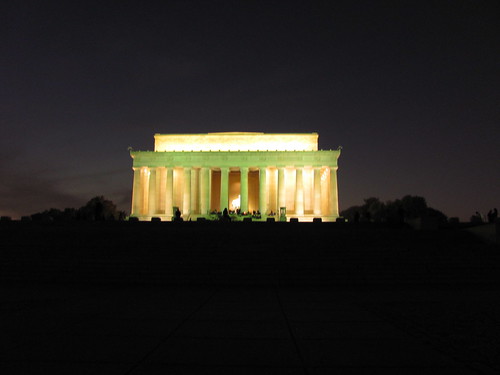
From this angle, the Lincoln Memorial stands alone, a bright beacon in the night

From this angle, the Lincoln Memorial stands alone, a bright beacon in the night
Metro Alert: Red Line Disruptions over the Weekend
This is a reminder that due to major track rehabilitation on the Red Line this weekend, Red Line riders may face significant delays. There will be no rail service between Medical Center and White Flint from 10PM tonight until opening Tuesday, January 19. The Grosvenor station will be closed to trains during this period.
Free shuttles will operate every 6-8 minutes during the day and every 15 minutes after 9:30PM. They will run between White Flint, Grosvenor, and Medical Center throughout the period of disruption.
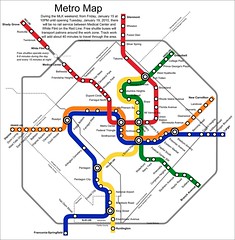
Make sure to check out Metro's information page for more details.
Free shuttles will operate every 6-8 minutes during the day and every 15 minutes after 9:30PM. They will run between White Flint, Grosvenor, and Medical Center throughout the period of disruption.

Make sure to check out Metro's information page for more details.
Thursday, January 14, 2010
Feed Issue: Resolved
For those of you who use a feed reader, you may have noticed a series of my recent flickr images go into your readers from this feed. I apologize for the problem, it has been resolved.
Four O'Clock Factoid: The West Wind
Four O'Clock Factoid is a daily feature on Track Twenty-Nine helping to get you through the workday with a bit of useless knowledge.
The Rio Grande Zephyr was a well-known passenger train operated by the Denver and Rio Grande Western before and after the formation of Amtrak. The Zephyr was one of only a few trains not taken over by Amtrak in 1971. It was a descendant of the California Zephyr, which operated from Chicago to Oakland over several railroads. Because the D&RGW elected to opt out of Amtrak, the California Zephyr ceased to exist, with Amtrak operating The City of San Francisco from Chicago to Oakland via Cheyenne and Ogden, while passengers could connect to the Rio Grande Zephyr at Denver and Ogden. In 1983, D&RGW turned the Zephyr over to Amtrak, which renamed the route the California Zephyr, and discontinued use of the route through Ogden.
The Rio Grande Zephyr was a well-known passenger train operated by the Denver and Rio Grande Western before and after the formation of Amtrak. The Zephyr was one of only a few trains not taken over by Amtrak in 1971. It was a descendant of the California Zephyr, which operated from Chicago to Oakland over several railroads. Because the D&RGW elected to opt out of Amtrak, the California Zephyr ceased to exist, with Amtrak operating The City of San Francisco from Chicago to Oakland via Cheyenne and Ogden, while passengers could connect to the Rio Grande Zephyr at Denver and Ogden. In 1983, D&RGW turned the Zephyr over to Amtrak, which renamed the route the California Zephyr, and discontinued use of the route through Ogden.
Metro's Blogger Roundtable a Success
Yesterday, I had the pleasure of attending a blogger roundtable with the General Manager of Metro, John Catoe. Mr. Catoe's conference room was filled with the transit bloggers of the region, and the discussion we had with the GM was candid and frank.
The meeting covered all the hotbutton issues, from the budget crisis to the aftermath of the June 22 Accident. Some of the bloggers were very upfront about their experience with what they see as rapidly deteriorating service, and Mr. Catoe understands their frustrations. Riders, he says, approach him frequently with complaints as he rides the system.
But his vision is one of a bright future for Metro. He knows it will be a hard road ahead for the transit agency. But that is not a deterrent for him. He is working to bring the agency back to where it should be.
You can read more of my reflections in a post I coauthored at Greater Greater Washington with fellow GGWer Michael Perkins.
Also make sure to check out We Love DC's article on the meeting; their writeup is superb.
The meeting covered all the hotbutton issues, from the budget crisis to the aftermath of the June 22 Accident. Some of the bloggers were very upfront about their experience with what they see as rapidly deteriorating service, and Mr. Catoe understands their frustrations. Riders, he says, approach him frequently with complaints as he rides the system.
But his vision is one of a bright future for Metro. He knows it will be a hard road ahead for the transit agency. But that is not a deterrent for him. He is working to bring the agency back to where it should be.
You can read more of my reflections in a post I coauthored at Greater Greater Washington with fellow GGWer Michael Perkins.
Also make sure to check out We Love DC's article on the meeting; their writeup is superb.
Wednesday, January 13, 2010
Four O'Clock Factoid: Chasing History
Four O'Clock Factoid is a daily feature on Track Twenty-Nine helping to get you through the workday with a bit of useless knowledge.
The Western and Atlantic Railroad is a rail line linking Atlanta, Georgia and Chattanooga, Tennessee. It is and has always been owned by the state of Georgia. It was chartered by the state to link the Chattahoochee and Tennessee Rivers and was the primary factor in Atlanta's rise as a transportation hub. It is famous for the "Great Locomotive Chase" which took place on April 12, 1862, when Union troops seized the locomotive General and attempted to burn bridges on the line to cut Confederate supply lines.
The Western and Atlantic Railroad is a rail line linking Atlanta, Georgia and Chattanooga, Tennessee. It is and has always been owned by the state of Georgia. It was chartered by the state to link the Chattahoochee and Tennessee Rivers and was the primary factor in Atlanta's rise as a transportation hub. It is famous for the "Great Locomotive Chase" which took place on April 12, 1862, when Union troops seized the locomotive General and attempted to burn bridges on the line to cut Confederate supply lines.
Wednesday Wrap: The Curtain Falls
Wednesday Weekly Wrap-Up is a feature looking back on transportation and planning news and opinions from the last week or so.
No links today, not in Wednesday Wrap anyway. I've decided to discontinue this feature in light of a few things:
No links today, not in Wednesday Wrap anyway. I've decided to discontinue this feature in light of a few things:
- You voted, and this is one of the two least popular features on Track Twenty-Nine.
- I've started a Twitter feed (available on the main T29 page) where I tweet news as I find it.
- There are plenty of other sites out there providing daily links.
Thanks for reading!
Tuesday, January 12, 2010
Four O'Clock Factoid: See the Water for the Park
Four O'Clock Factoid is a daily feature on Track Twenty-Nine helping to get you through the workday with a bit of useless knowledge.
Tom McCall Waterfront Park is a park in Portland, Oregon named after a former governor. The park replaced Harbor Drive, the construction of which in 1940 cut downtown off from the Willamette River. Governor McCall set in motion the removal of the freeway and the creation of a park in its stead.
Transit Tuesday: Bowl Training
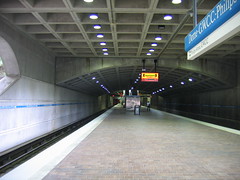 Transit Tuesday is a weekly feature or profile on transit.
Transit Tuesday is a weekly feature or profile on transit.Last week saw the end of the college football season (alas! It's never long enough) with several exciting bowl games. Of the 30 bowl venues, 11 have rail transit stations within 0.5 miles. The Cotton Bowl Classic was, until this year, played at the Cotton Bowl itself, which is, as of this year, within walking distance of the DART light rail. But this year's game was moved to the new Cowboys Stadium in Arlington, far from rail, even as it arrived at the former home of the game.
The 11 bowl venues close to rail transit are:
- The New Orleans Bowl and the Sugar Bowl, both played at the Superdome, about 1/2 mile from the St. Charles Streetcar line
- The Poinsettia Bowl and the Holiday Bowl, both played at Qualcomm Stadium, which has an adjacent station on the San Diego Trolley light rail.
- The Little Ceasars Pizza Bowl, played at Detroit's Ford Field, about 0.4 miles from the People Mover's Broadway Station.
- The Meineke Car Care Bowl, played at Bank of America Stadium, about 0.4 miles from the Lynx Stonewall light rail station in Charlotte.
- The Emerald Bowl, played at San Francisco's AT&T Park, adjacent to the King & 2nd Muni Metro light rail stop and 2 blocks from the terminus of the Caltrain regional rail.
- The EagleBank Bowl, played at RFK Stadium in Washington, DC, just 0.3 miles from the Stadium-Armory Metro station.
- The Texas Bowl, played at Reliant Stadium, just 0.5 miles from the Houston METRORail stop at Reliant Park.
- The Insight Bowl, played at Sun Devil Stadium, which has an adjacent station on the Phoenix Light Rail.
- The Chick-fil-a Bowl, played in the Georgia Dome, which is adjacent to two MARTA stations - Dome/GWCC/Philips Arena/CNN Center and Vine City.
- The International Bowl, played at Toronto's Rogers Centre, 0.4 miles from the Union Station stop on the Subway and GO Transit's commuter rail lines.
Monday, January 11, 2010
Four O'Clock Factoid: 'State' of the Art
Four O'Clock Factoid is a daily feature on Track Twenty-Nine helping to get you through the workday with a bit of useless knowledge.
The State Street Subway in Chicago is home to the world's longest subway station. The island platform actually stretches continuously through four stations: Lake, Washington, Monroe, and Jackson. The platform is 3,500 feet in length. While labeled as four separate stations, it is essentially one long station with four stopping points.
Monday Shot: Trademark
Monday Shot isn't quite espresso, but hopefully this weekly transit picture will help get your week started.

Cable Cars are a trademark of San Francisco. Thisone is traveling westbound on California Street.
My photostream

Cable Cars are a trademark of San Francisco. This
My photostream
Friday, January 8, 2010
Four O'Clock Factoid: Auld Lang Syne
Four O'Clock Factoid is a daily feature on Track Twenty-Nine helping to get you through the workday with a bit of useless knowledge.
Times Square-42nd Street is the busiest station complex in the New York subway system. In 2008, almost 61 million passengers used the station. It is home to four trunk lines and the 42nd Street Shuttle. Twelve services call at the station: the A, C, E, 1, 2, 3, 7, N, Q, R, W, and the Shuttle.
Times Square-42nd Street is the busiest station complex in the New York subway system. In 2008, almost 61 million passengers used the station. It is home to four trunk lines and the 42nd Street Shuttle. Twelve services call at the station: the A, C, E, 1, 2, 3, 7, N, Q, R, W, and the Shuttle.
Tweet Time
 In an effort to keep up with the times and also to better tailor Track Twenty-Nine to the needs of my readers, I have started a Twitter account.
In an effort to keep up with the times and also to better tailor Track Twenty-Nine to the needs of my readers, I have started a Twitter account.I'll be posting news items as I come across them, and you can expect to see some personal messages as well.
You can follow me at: http://twitter.com/Tracktwentynine.
And for those of you who visit the Track Twenty-Nine site (as opposed to using a feed reader), you'll notice that I've added a Twitter updates box at the top right of the page.
Photo Friday: Widewater
Photo Friday is a series showcasing a photo of mine each week. Enjoy!
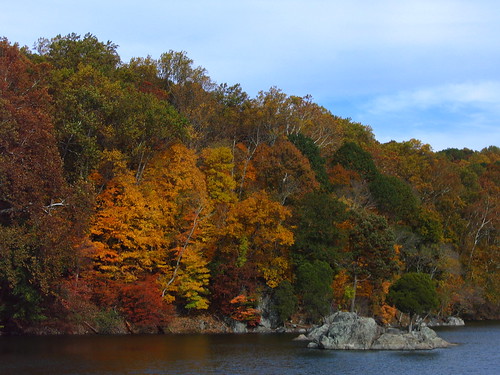
Reds, oranges, and yellows contrast nicely with the blues and greens at the Widewater of the C&O Canal just south of Great Falls
My photostream

Reds, oranges, and yellows contrast nicely with the blues and greens at the Widewater of the C&O Canal just south of Great Falls
My photostream
Thursday, January 7, 2010
Four O'Clock Factoid: Gare du Nord
Four O'Clock Factoid is a daily feature on Track Twenty-Nine helping to get you through the workday with a bit of useless knowledge.
Paris' Gare du Nord is the busiest train station in Europe. It hosts trains bound for London (via the Chunnel), northern France, Belgium, and Germany. An estimated 180 million travelers per year pass through the station. Service began in 1864, before the station was even complete.
Paris' Gare du Nord is the busiest train station in Europe. It hosts trains bound for London (via the Chunnel), northern France, Belgium, and Germany. An estimated 180 million travelers per year pass through the station. Service began in 1864, before the station was even complete.
Wednesday, January 6, 2010
Four O'Clock Factoid: Questions 67 and 68
Four O'Clock Factoid is a daily feature on Track Twenty-Nine helping to get you through the workday with a bit of useless knowledge.
One of the longest running pop/rock and roll groups in the country started out with the name Chicago Transit Authority. Famous for many hits in the 1970s and 1980s, their rock/jazz fusion proved popular. The band began calling themselves by that name in 1968, and their first album was eponymous. Unfortunately, the actual CTA threatened to sue the band, so the group dropped the "Transit Authority" and grew famous as just Chicago.
One of the longest running pop/rock and roll groups in the country started out with the name Chicago Transit Authority. Famous for many hits in the 1970s and 1980s, their rock/jazz fusion proved popular. The band began calling themselves by that name in 1968, and their first album was eponymous. Unfortunately, the actual CTA threatened to sue the band, so the group dropped the "Transit Authority" and grew famous as just Chicago.
Wednesday Wrap: 1/6/10
Wednesday Weekly Wrap-Up is a feature looking back on transportation and planning news and opinions from the last week or so.
- On Track: Make sure to check out the Transport Politic's look at transit projects on track to be completed, expanded, or started in 2010.
- Beats Shoveling It: The Baltimore Streetcar Museum recently got to break out its snow sweeper to clear the tracks during the Blizzard of '09.
- Harmony Express: China's new Harmony Express is the world's fastest train, reaching a top speed of 217 mph, making the journey from Wuhan to Guangzhou in under 3 hours.
- Rethinking LRT: After initially rejecting plans for light rail, Virginia Beach is now planning TOD to provide a welcoming gateway for riders on the Tide Light Rail in adjacent Norfolk. Perhaps one day, the Tide will make it to the Beach.
- 7000+: Vice President Joe Biden is estimated to have taken more than 7000 round trips on Amtrak in his career. He has penned another piece supporting passenger rail.
- Clunkers for Junkyards: US car ownership saw its first major decline since the DOT first started keeping track in 1960. The fleet shrunk by about 4 million vehicles.
Tuesday, January 5, 2010
Four O'Clock Factoid: White City
Four O'Clock Factoid is a daily feature on Track Twenty-Nine helping to get you through the workday with a bit of useless knowledge.
The World's Columbian Exposition, held in Chicago in 1893 was a major event in the history of the field of planning. It has also been called the Chicago World's Fair and was held to celebrate the 400th anniversary of Christopher Columbus' arrival in the New World. Two of the major designers of the fair were Daniel Burnham and Frederick Law Olmsted. The exposition was held in Jackson Park, along the shore of Lake Michigan on the south side of Chicago.
Designed to replicate the ideal city of Burnham and Olmsted, the Beaux Arts and Neoclassicism were major elements of the exposition. Symmetry, canals, and a lagoon were major features of the landscape designed by Olmsted.
The popularity of the fair and its design led to the City Beautiful movement and directly influenced urban planning. While much of the exposition, known as the White City, was torn down after the fair, one lasting example of its impact is Washington's National Mall, which was designed along the same principles.
The first Ferris Wheel was constructed at the fair. Standing 264 feet tall, it dwarfed other buildings on the site.
The exposition also played a role in the song America the Beautiful, when it inspired the writer, Katharine Lee Bates, as a gleaming alabaster city.
The World's Columbian Exposition, held in Chicago in 1893 was a major event in the history of the field of planning. It has also been called the Chicago World's Fair and was held to celebrate the 400th anniversary of Christopher Columbus' arrival in the New World. Two of the major designers of the fair were Daniel Burnham and Frederick Law Olmsted. The exposition was held in Jackson Park, along the shore of Lake Michigan on the south side of Chicago.
Designed to replicate the ideal city of Burnham and Olmsted, the Beaux Arts and Neoclassicism were major elements of the exposition. Symmetry, canals, and a lagoon were major features of the landscape designed by Olmsted.
The popularity of the fair and its design led to the City Beautiful movement and directly influenced urban planning. While much of the exposition, known as the White City, was torn down after the fair, one lasting example of its impact is Washington's National Mall, which was designed along the same principles.
The first Ferris Wheel was constructed at the fair. Standing 264 feet tall, it dwarfed other buildings on the site.
The exposition also played a role in the song America the Beautiful, when it inspired the writer, Katharine Lee Bates, as a gleaming alabaster city.
Monday Shot Extra: All Lined Up
Monday Shot isn't quite espresso, but hopefully this weekly transit picture will help get your week started.
Because I was on vacation this weekend and traveling yesterday, I didn't have time to put together Transit Tuesday. I hope a bonus edition of Monday Shot will suffice in its place.
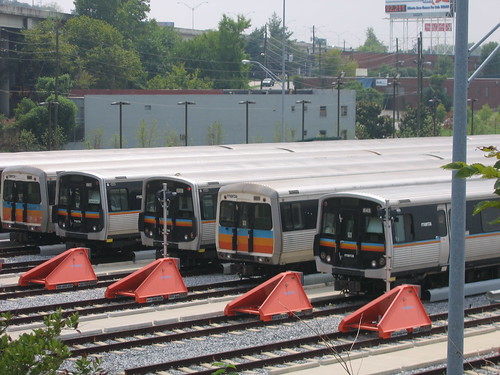
MARTA trains are lined up at the end of the Armour Rail Yard in this shot. Taken from Piedmont Road near the southbound Buford Highway Connector ramp.
Because I was on vacation this weekend and traveling yesterday, I didn't have time to put together Transit Tuesday. I hope a bonus edition of Monday Shot will suffice in its place.

MARTA trains are lined up at the end of the Armour Rail Yard in this shot. Taken from Piedmont Road near the southbound Buford Highway Connector ramp.
Monday, January 4, 2010
Four O'Clock Factoid: Sunrise/Sunset
Four O'Clock Factoid is a daily feature on Track Twenty-Nine helping to get you through the workday with a bit of useless knowledge.
Portland's Washington Park Station is the second deepest subway station in the world at 260 feet below grade. It is the only completely underground station on Portland's MAX light rail. The platforms have been nicknamed "sunrise" and "sunset" based on the color of the ceiling accents.
Portland's Washington Park Station is the second deepest subway station in the world at 260 feet below grade. It is the only completely underground station on Portland's MAX light rail. The platforms have been nicknamed "sunrise" and "sunset" based on the color of the ceiling accents.
Monday Shot: Albertan Skyline
Monday Shot isn't quite espresso, but hopefully this weekly transit picture will help get your week started.
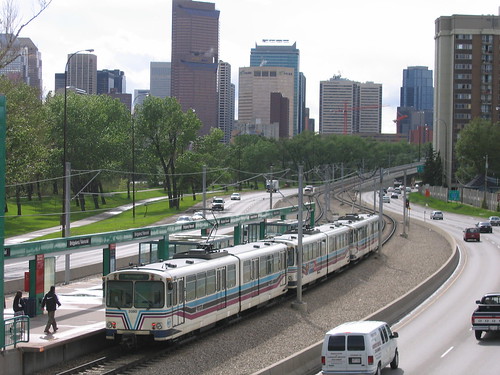
Calgary presents a dramatic backdrop to this freeway median C-Train station
My photostream

My photostream
Subscribe to:
Posts (Atom)









